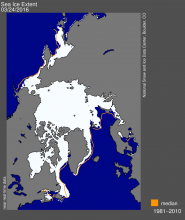Over the past several decades, the Arctic has warmed roughly twice as fast as the rest of the planet. Record low sea-ice extents, thawing permafrost, and accelerated melting of the Greenland Ice Sheet are consequences of this uneven warming, according to Mark C. Serreze, the director of the National Snow and Ice Data Center in Boulder, Colo. In the March issue of EARTH Magazine, Serreze brings insight and context to the latest Arctic measurements.
Dr. Serreze notes that the events of this past year were unprecedented in his more than three decades of experience in the Arctic. As he describes, a heat wave in the winter of 2015-2016 inhibited the normal winter sea-ice growth, and stormy conditions during the summer - "the stormiest summer over the central Arctic Ocean in [his] experience" - churned the Arctic waters, exacerbating the melting. Serreze concludes by acknowledging the role of natural variability in influencing extreme events, but cautions that "by loading the atmosphere with greenhouse gases, we've also loaded the dice." Read Serreze's full comment in the March issue of EARTH: https://www.earthmagazine.org/article/comment-crazy-times-arctic.
The March issue of EARTH Magazine will be available soon. In the meantime, read stories in the February issue about how cave paintings discovered in France have confirmed the existence of a mystery bison species. Or learn how a certain type of fungi plays an eco-engineering role in slope ecosystems. For these stories and more, subscribe to EARTH Magazine.

